The phosphorylation state of MRLC is polyamine dependent in intestinal epithelial cells
- PMID: 21068360
- PMCID: PMC3023191
- DOI: 10.1152/ajpcell.00247.2010
The phosphorylation state of MRLC is polyamine dependent in intestinal epithelial cells
Abstract
Cell migration is important to the integrity of the gastrointestinal tract for the normal movement of cells from crypt to villi and the healing of wounds. Polyamines are essential to cell migration, mucosal restitution, and, hence, healing. Polyamine depletion by α-difluoromethyl ornithine (DFMO) inhibited migration by decreasing lamellipodia and stress fiber formation and preventing the activation of Rho-GTPases. Polyamine depletion increased the association of the thick F-actin cortex with phosphorylated myosin regulatory light chain (pMRLC). In this study, we determined why MRLC is constitutively phosphorylated as part of the actin cortex. Inhibition of myosin light chain kinase (MLCK) decreased RhoA and Rac1 activities and significantly inhibited migration. Polyamine depletion increased phosphorylation of MRLC (Thr18/Ser19) and stabilized the actin cortex and focal adhesions. The Rho-kinase inhibitor Y27632 increased spreading and migration by decreasing the phosphorylation of MRLC, remodeling focal adhesions, and by activating Rho-GTPases. Thus phosphorylation of MRLC appears to be the rate-limiting step during the migration of IEC-6 cells. In addition, increased localization of RhoA with the actin cortex in polyamine-depleted cells appears to activate Rho-kinase. In the absence of polyamines, activated Rho-kinase phosphorylates myosin phosphatase targeting subunit 1 (MYPT1) at serine-668 leading to its inactivation and preventing the recruitment of phosphatase (protein phosphastase, PP1cδ) to the actomyosin cortex. In this condition, MRLC is constitutively phosphorylated and cycling does not occur. Thus activated myosin binds F-actin stress fibers and prevents focal adhesion turnover, Rho-GTPase activation, and the remodeling of the cytoskeleton required for migration.
Figures
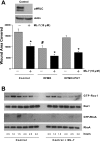
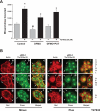


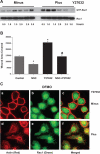
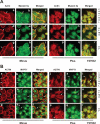
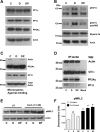
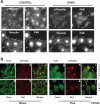
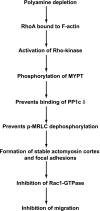
Similar articles
-
Role of myosin regulatory light chain and Rac1 in the migration of polyamine-depleted intestinal epithelial cells.Am J Physiol Gastrointest Liver Physiol. 2007 Apr;292(4):G983-95. doi: 10.1152/ajpgi.00356.2006. Epub 2006 Dec 14. Am J Physiol Gastrointest Liver Physiol. 2007. PMID: 17170026
-
Aurora B but not rho/MLCK signaling is required for localization of diphosphorylated myosin II regulatory light chain to the midzone in cytokinesis.PLoS One. 2013 Aug 7;8(8):e70965. doi: 10.1371/journal.pone.0070965. eCollection 2013. PLoS One. 2013. PMID: 23951055 Free PMC article.
-
Myosin phosphatase targeting subunit 1 affects cell migration by regulating myosin phosphorylation and actin assembly.Exp Cell Res. 2005 Apr 1;304(2):506-17. doi: 10.1016/j.yexcr.2004.11.025. Epub 2004 Dec 30. Exp Cell Res. 2005. PMID: 15748895
-
Role of myosin light chain phosphorylation in the regulation of cytokinesis.Cell Struct Funct. 2001 Dec;26(6):639-44. doi: 10.1247/csf.26.639. Cell Struct Funct. 2001. PMID: 11942620 Review.
-
Rho-associated kinase-dependent contraction of stress fibres and the organization of focal adhesions.J R Soc Interface. 2011 Mar 6;8(56):305-11. doi: 10.1098/rsif.2010.0419. Epub 2010 Sep 8. J R Soc Interface. 2011. PMID: 20826475 Free PMC article. Review.
Cited by
-
Defining suitable reference genes for RT-qPCR analysis on intestinal epithelial cells.Mol Biotechnol. 2013 Jul;54(3):930-8. doi: 10.1007/s12033-012-9643-3. Mol Biotechnol. 2013. PMID: 23292893
-
Spermine protects intestinal barrier integrity through ras-related C3 botulinum toxin substrate 1/phospholipase C-γ1 signaling pathway in piglets.Anim Nutr. 2022 Mar;8(1):135-143. doi: 10.1016/j.aninu.2021.06.016. Epub 2021 Oct 13. Anim Nutr. 2022. PMID: 34977383 Free PMC article.
-
Activation of Dbl restores migration in polyamine-depleted intestinal epithelial cells via Rho-GTPases.Am J Physiol Gastrointest Liver Physiol. 2011 Jun;300(6):G988-97. doi: 10.1152/ajpgi.00409.2010. Epub 2011 Mar 3. Am J Physiol Gastrointest Liver Physiol. 2011. PMID: 21372162 Free PMC article.
-
Absence of keratins 8 and 18 in rodent epithelial cell lines associates with keratin gene mutation and DNA methylation: Cell line selective effects on cell invasion.Exp Cell Res. 2015 Jul 1;335(1):12-22. doi: 10.1016/j.yexcr.2015.04.003. Epub 2015 Apr 14. Exp Cell Res. 2015. PMID: 25882495 Free PMC article.
-
Scribble, Lgl1, and myosin IIA interact with α-/β-catenin to maintain epithelial junction integrity.Cell Adh Migr. 2023 Dec;17(1):1-23. doi: 10.1080/19336918.2023.2260645. Epub 2023 Sep 24. Cell Adh Migr. 2023. PMID: 37743653 Free PMC article.
References
-
- Alessi D, MacDougall LK, Sola MM, Ikebe M, Cohen P. The control of protein phosphatase-1 by targeting subunits. The major myosin phosphatase in avian smooth muscle is a novel form of protein phosphatase-1. Eur J Biochem 1210: 1023–1035, 1992 - PubMed
-
- Amano M, Ito M, Kimura K, Fukata Y, Chihara K, Nakano T, Matsuura Y, Kaibuchi K. Phosphorylation and activation of myosin by Rho-associated kinase (Rho-kinase). J Biol Chem 271: 20246–20249, 1996 - PubMed
Publication types
MeSH terms
Substances
Grants and funding
LinkOut - more resources
Full Text Sources
Research Materials

